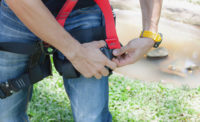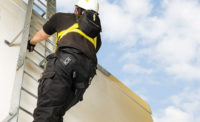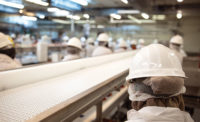All are guilty of contributing to the degradation of safety and fall protection equipment. With so many hidden factors influencing the performance of equipment, employers and employees alike must be able to spot signs of degradation and know when it's time to replace a harness or lanyard - the critical pieces of fall protection gear.
The American National Standards Institute (ANSI) outlines good, common sense voluntary compliance standards in ANSI Z 359.1 for inspecting fall protection equipment, including checking the gear prior to each use and having the equipment inspected at least once a year by a competent, trained person. It's like checking the tires on your car before a road trip. It's imperative to make sure the gear is ready to do its job.
What to look for
Let's take a look at some of the most common causes of fall protection equipment degradation:
Look for support
The proper selection of high-quality fall protection materials often can mean better survival and all-important performance of equipment under even extreme conditions. For example, polyester webbing offers superior resistance to acids and UV degradation. In addition, some products incorporate Kevlar webbing, which offers heat resistance capabilities exceeding 1,000 degrees F. A Kevlar webbing product would minimize damage by weld slag. While costing about twice as much as polyester, Kevlar lasts significantly longer.When it comes to serviceable items, such as self-retracting devices, they should be removed from service when inspection reveals excessive wear and tear, then sent to a factory-authorized service center, where they can be serviced, re-certified and put back into use. When there are questions about whether a particular piece of gear has sustained excessive wear and tear, users should rely on the manufacturer for support.
Oftentimes manufacturers encourage customers to send equipment back for inspection if they are uncertain about the product's integrity. Some customers simply want a third party to examine and approve a product's performance. This can be a good idea, as in many cases degradation of equipment can be difficult to spot. A harness that may look sound to the naked eye can often have small holes or tears that impact its performance in a fall.
Judgement call
Still, users and/or safety managers can get a good idea of their safety equipment's integrity by performing random checks. If you have 100 harnesses that are all used under virtually the same circumstances, take just one of those harnesses and have it thoroughly inspected and tested to see if it still meets safety standards. This will give you a good indication of the condition of the other 99.Determining when to replace equipment is largely a judgement call. Every situation in which the equipment is used, however, is unique, with a different set of conditions. In some cases, information available on a general basis sometimes is not enough. More experience and training can provide additional tools and information to help those inspecting fall protection gear improve their judgement.
Many reputable manufacturers offer inspection training courses, which combined with on-site experiences and product specification guidelines, can create a more rounded understanding of when and how to inspect gear.
At the end of the day, you're talking about a piece of safety gear that potentially will save someone's life, so always err on the side of safety and inspect your gear often.
SIDEBAR: FP equipment: Good, better, best
Choosing the right fall protection equipment for the job and paying the price you can afford is a tricky balance. Fall protection equipment can be divided into three basic categories. Knowing them can help you make your choice.1) Economy-priced. These lower-end products, categorized as "good" and which at least meet OSHA compliance standards, have fewer features but may be right for certain working conditions. Example: when large numbers of temporary workers are brought in for a specific, short-term task.
2) Mid-range. These "better" products are preferred for everyday workers required to wear a harness while performing their jobs. Comfort, fit, durability and adjustment are critical features.
3) Top-of-the-line. The "best" category of fall protection products provides all the qualities of mid-range products, plus added comfort and support features. These higher-priced products can also include a corporate logo, custom colors or special configurations.


